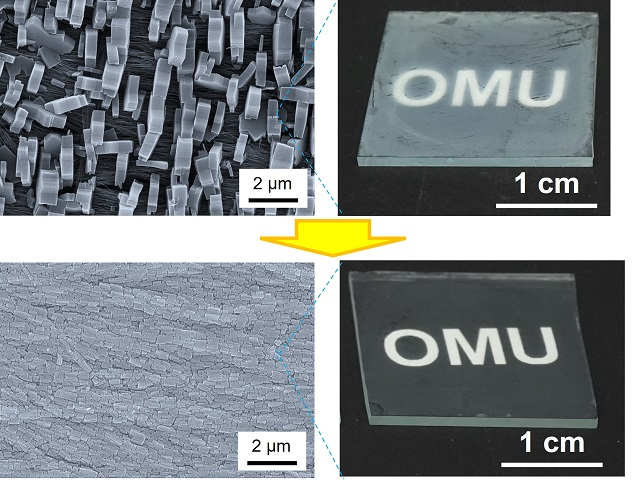Research News
Aug 21, 2024
- Engineering
Quality control: neatly arranging crystal growth to make fine thin films
Clean energy products could be made from metal-organic frameworks
Modulating quality
The metal-organic framework thin film synthesized at top did not involve a modulator, while the finely arranged version above did.
Credit: Osaka Metropolitan University

Table salt and refined sugar look white to our eyes, but that is only because their individual colorless crystals scatter visible light. This feature of crystals is not always desirable when it comes to materials for optical and electrical devices, however.
Metal-organic frameworks are one such material. Crystalline with micropores, thin films of these nanomaterials have been attracting attention as a next-generation material that could also have an impact on environmental issues such as hydrogen storage and carbon dioxide capture. An Osaka Metropolitan University, Graduate School of Engineering team has found a way to control the growth of crystals on such thin films so that light scattering is reduced significantly.
Associate Professor Kenji Okada and Professor Masahide Takahashi led the team in developing a technique for forming thin films on substrates by having the crystals grow in an orderly manner through the use of a modulator. A mixture of diluted acetic acid, the main acid of vinegar, and sodium acetate made up the modulator, which interacted with the copper-based medium to grow crystals in only one direction.
By arranging the crystals neatly without gaps, the team succeeded in fabricating a thin film of unprecedented high quality.
“The thin films fabricated in this research have numerous molecular-sized pores that allow light to pass through them well,” Professor Okada explained. “They are expected to be used as optical sensors, optical elements, and transparent gas adsorption sheets that utilize the change in optical properties during molecular adsorption.”
The findings were published in Nanoscale.
Funding
The present work is partially supported by Grant-in-Aid from the Ministry of Education, Culture, Sports, Science and Technology (MEXT), administrated by the Japan Society for the Promotion of Science (JSPS) (JP20H00401), and by JST, PRESTO Grant Number JPMJPR19I3, Japan, and by Grant-in-Aid for Transformative Research Areas (A) “Supra-ceramics” (JSPS KAKENHI Grant Numbers JP22H05142 and JP22H05144).
Paper information
Journal: Nanoscale
Title: Improved optical quality of heteroepitaxially grown metal–organic framework thin films by modulating the crystal growth
DOI: 10.1039/D4NR01885K
Authors: Yuka Koseki, Kenji Okada, Shotaro Hashimoto, Shun Hirouchi, Arisa Fukatsu, Masahide Takahashi
Published: 20 Jun 2024
URL: https://doi.org/10.1039/D4NR01885K
Contact
Graduate School of Engineering
Kenji Okada
Email: k_okada[at]omu.ac.jp
Masahide Takahashi
Email: masa[at]omu.ac.jp
*Please change [at] to @.
SDGs
